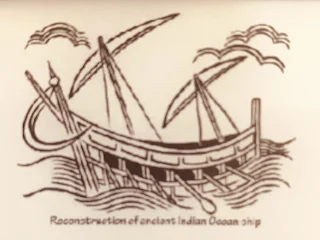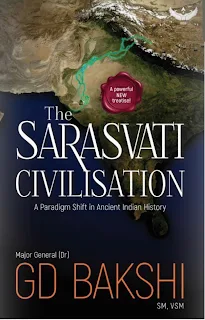The Incredible History of India's Geography
Author: Sanjeev Sanyal
2023 seems to be the year when India showcases to the world that it has arrived. With the euphoria of the moon landing still lingering on every Indian psyche, the G20 summit put India and its leaders on a pedestal. Seeing Modi walking bare feet, shoulder to shoulder with foreign leaders reminds Indians that they have come a long way since they were looted of their prized collection and left out in the cold as a basket case struggling as once the world's most impoverished countries.
It is interesting to note that throughout the history of the world, India (and China) have not been considered a poor nation. In fact, before the Industrial Revolution and the Great Game, these countries combined provided more than two-thirds of the world's GDP. The exploration and Western understanding of world geography changed the history of the East and the world at large.
Sanjeev Sanyal, an economist, a Rhodes scholarship, and an economic advisor to PM Modi, is also a prolific writer and speaker on India's untold ancient history. He is one of the growing band of people who decry that the history of India that is told and taught to its people and the world is Eurocentric and Moghul-centric.

In this book, Sanyal takes a peek into the geography of India and sees how it influenced its history over the years. The beginning of time started with the supercontinent of Rodinia 1 billion years ago. About 250 million later, in the pre-Cambrian period, the supercontinent began to drift apart. (The pre-Cambrian era had single-cell organisms; the Cambrian explosion had large numbers of complex organisms.) Another 250 million years later, the continents reassembled to form Pangea. Then Pangea split into a northern continent, Laurasia, and Gondwana, the southern continent. Laurasia split further to include North America, Europe and Asia, and Gondwana to Africa, South America, Antarctica and India. India separated from Africa and collided with the European plate. The collision is still in progress, and the Himalayas are still seismically unstable. River Saraswati went on under this tectonic shift.
The book discusses the migration of people and animals out of Africa until the world geography came to be as it is. After that, things become fuzzy. Where did all the milestones in human civilisation happen? Where did farming start? Was it in regions around Persia and spread outwardly, or did they begin independently elsewhere, like in the Indic part?
Genetic studies now support an 'out of India' theory rather than the 'Aryan Invasion Theory', which gave the European powers to legitimately rule over and civilised people in India.
Archaeologists and historians have differing views on India's early history. Vedic traditions support the possible existence of a glorious river named Saraswati upon which the sophisticated cities of the Harappan Civilisation developed. Its drying up altered the course of history. People started migrating out of Harappan. Are Harappans the same as the Vedic people? If horseback riding invaded Harappan, why is there no evidence of destruction as explained by the Aryan Invasion Theory? It is unbelievable that horsemen could be civilised, knowledge-yielding planters and town planners.
Geography and the forces of nature played an important role in Indian history. A vast coastline drew maritime visitors and sent explorers overseas. A ragged terrain over the North was the avenue of a busy highway with traffic jams of convoys of bullock carts. The tributaries of the great rivers for the Himalayas also provided two major 'highways' of trade - the North-South and the East-West axes.
The book further discusses the various invasions via land from the North by Greeks and Islamic invaders. As the land routes were closely controlled, the. Europeans needed an alternate way of trade. India was also a place with internal wars by local chieftains in their zest to build Empires, Maurya, Gupta, Cholas, Pallavas, Pandyas, Cheras, and others.
Bharat is supposed to have its name from the victor of the 'Battle of Ten Kings', the Bharata tribe, as mentioned in Rigveda. The wheel of 'Chakravartin' (Universal Monarch) became the imperial symbol and survived through the Maurya dynasty, Buddhism and finally made it to the Indian flag.
 |
The area around Punjab and Afghanistan
were ardent Shakti worshippers |
India is proud to say it is the only country in the world where lions and tigers co-exist.
The Romans and India had a robust business exchange in the first Century CE. Unfortunately, it was lopsided, favouring the Indians so much that Rome had cut down imports of luxury items from India. Jews came to trade in India during King Solomon's era, but Jewish refugees trickled in after the destruction of the Second Temple in 70 CE to settle in Kerala. St Thomas, the apostle, landed there to convert people who refer to themselves as Syrian Christians.
Indians have a long maritime history, trading with the Middle East, Greeks, Romans, to South East Asia and all the way to China. Chinese Buddhist scholars frequented India to delve into Buddhism. Details of their journeys are nicely documented.
The Arabs were trading even before Islam. The Mohamadans, the Arabs, who went on a conquering spree after the Prophet's demise, reached Sindh as invaders in the 8th Century. They were warded off. The Turks attacked Aghanistan, then a Hindu region, and captured Ghazni. Mahmud of Ghazni kept repeatedly attacking Hindu temples for their enormous wealth. Slowly, these Islamic invaders reached Delhi and started making their mark in Indian history. Others followed -Thuglaq and Moghuls.
 |
| Indian seafaring vessel |
The Chinese seamen were going places in the seas with their mammoth vessels. It all came to a halt in the 15th Century. Meanwhile, the Portuguese and other Europeans were making baby steps in finding a sea route to the East, bypassing the Muslim-controlled land routes.
The animosity between the Europeans and Muslims, leftovers of the Crusade Wars, continued on the Eastern shores of Africa and the Western coasts of India when Portuguese ships circumvented Africa to reach there. Arab traders, being long there and naturally having developed a working relationship with the local rulers, showed their displeasure. Hostility was reciprocated, and the Portuguese slowly gained ground in India with their superior weapons. Evangelists and later other European nations came to be drawn in, like bees drawn to pollen.
The pilfering and looting progressed at an industrial scale afterwards. The rest of the story we know. India and China contributed two-thirds of the world's GDP when the British sauntered in. 200 years later, when they left, India was left with a begging bowl as one the poorest nations in the world, together with other fellow colonies. Two Industrial Revolutions left whilst the Indians were busy defending their own land and amongst each other.
The local looming industry started losing to Spinning Jenny, but the railways came to India, and India had to foot the bill. Of course, it was a shot in the arm for British engineers and industrialists.
At the beginning of all these shenanigans, the Europeans who thought the world was flat soon managed to draw a composite picture of a round earth on a flat map. The colonial masters left in 1947, but not after slicing the country into two. There were still pockets of the country that still needed to be in the Union of India. The princely states had to be arm-twisted to choose India or Pakistan. The Portuguese had to be chased off from Goa. The French needed to be evacuated from Pondicherry. Pakistan continued starting skirmishes in Kashmir, the problems of which continue till date. The two parts of Pakistan began clashing in 1971 and parted ways.
















.jpeg)
.jpeg)









